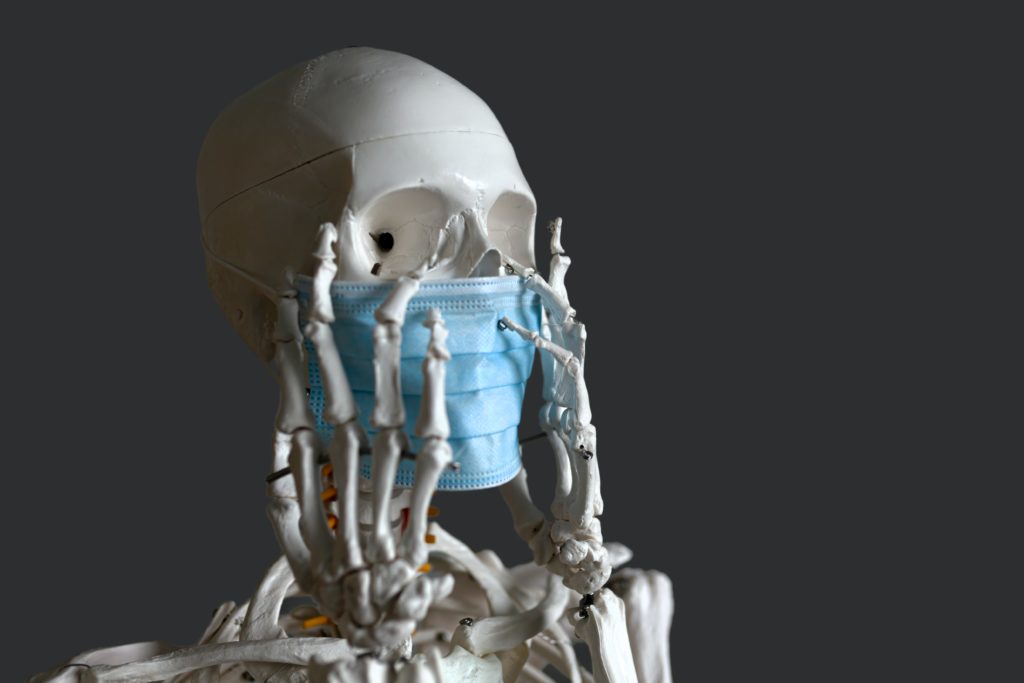All fields are required
Posted in Our Blog,Outbreaks & Recalls on October 27, 2020

It’s almost Halloween! In a normal year, we all know what sort of celebrations this would entail. Unfortunately, this year is not normal. It’s COVID Halloween. There’s an ongoing public health crisis. Uncontrolled community spread of the novel coronavirus is ongoing. As of this writing, cases are up, and deaths, previously wrestled down from peak levels, have climbed back up above the thousand a day mark.
So, given the facts, what can we get away with? What sort of things should you be doing, according to public health experts, and what sort of things are best avoided?
Location, location, location
This article will contain general recommendations. What’s safe to do, however, depends on how many cases of COVID are in your area. Different localities will have different restrictions. No blog article, no matter how informative or well-written, should replace the guidance of local health experts or officials. First and foremost, look to them. Listen to your local health department and medical professionals, and follow whatever guidance has been put in place to keep you safe.
Few are the places in late October of 2020, unfortunately that have entirely rid themselves of the coronavirus. Even where cases are low, the possibility remains that they could jump up again. People are free to travel from viral hotspots to locales that have fared better. Halloween falls on a Saturday this year, raising the spectre of quarantine-frustrated and socially deprived revelers throwing caution to the wind.
All of this is to say that our hard-won progress against the novel coronavirus could be undone by imprudent behavior. It’s tempting to think that we can return to February, but reality is a stubborn thing, and it’s better that we meet it on its own terms. So: what activities are COVID-safe going into Halloween, and which ones aren’t?
Different activities, different levels of risk
There are lower-risk activities that you can participate in without having to worry about transmission. The CDC recommends activities with the people that you live with, such as pumpkin carving or a Halloween movie night; socially-distanced activities outside at a safe distance, like pumpkin carving, that don’t involve incidental close contact. The unifying theme here is that you’re doing stuff with people in your household or bubble and keeping contact with those outside at the level of the virtual, the distanced, and the outdoors.
Some activities which you might think safe are actually listed as medium risk by the CDC. These include one-way trick or treating, where bags are set out beforehand for trick-or-treaters to pick up without having to interact directly with another person. Parades are considered medium risk, even if appropriately distanced and without too many participants. So are visits to pumpkin patches, orchards, haunted forests, and other COVID-proofed outdoor activities.
Whatever you do, you’ll want to avoid activities which the CDC has seen fit to classify as high risk. These include conventional trick or treating, as well as trunk-or-treating, where people hand out candy from cars. Indoor costume parties are, obviously, a no-go. That applies even moreso if they’re conducted without masks, ventilation, or limits on attendance.
Remember that there are cheap, effective ways of limiting transmission: masks, handwashing, and social distancing. These methods cost little, are available to everyone, and can cut your risk of exposure by a significant amount. Whatever you’re doing on Halloween, you should remember to stick to these as first principles.
If you’re infected with COVID-19, or if you’re at risk for contracting COVID-19, the best course of action is to stay home. Masking up, maintaining distance, and avoiding poorly-ventilated indoor areas serve to reduce the risk of transmission. They don’t eliminate it.
How does it spread?
We know that the SARS CoV-2 virus can be spread through droplets that are expelled when we breathe, talk, sneeze, or cough. Wearing a mask will corral many of these droplets so that they can’t fly very far from your mouth. It’s not a perfect solution: the effectiveness of masks hinges on the material they’re made from and how well they’re used, amongst other things. What we know is that they’re cheap, widely available, and proven to reduce risk of transmission.
We now also know that the virus which causes COVID-19 can also float through the air on aerosols. It’s not bound by transport via droplets that are big enough to see: it can move on tiny drops that are light enough to be borne this way and that by air currents. Because the virus can spread on aerosols, the risk profile of indoor spaces is high. You don’t just have to worry about staying out of the way of particles sprayed by unmasked mouths or noses: you also have to think about how the virus accumulates in poorly ventilated air.
An apt comparison is secondhand smoke. If you’re trying to avoid it, the worst place to be is right next to the person who’s smoking. If you’re in a room with them, however, you need to have some windows open and air circulating to avoid exposing yourself. The virus hangs on the air in aerosols, according to the latest guidance; like smoke, it accumulates in poorly-ventilated rooms, becoming more concentrated over time.
Takeaways
The takeaways here are the same as ever. Wear your mask. Avoid crowds and poorly ventilated indoor spaces. Forms of socializing that take you inside of 6 feet with another person are riskier than those that don’t. Be careful about what you’re touching, and make sure that it doesn’t include your eyes, nose, or mouth.
And, if you can manage, remember to have fun! Lord knows we all need it this COVID Halloween. There are ways of socializing this Halloween that are lower risk than others. Please take advantage of them.
By: Sean McNulty
Notifications